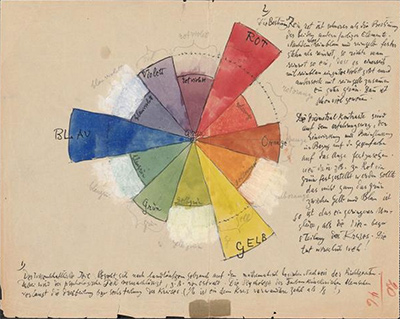Paul Klee was truly fascinated by colour
Paul Klee was an artist well known for his striking depictions of the human face, his abstract (and somewhat cubist artworks) and his great influence on German Expressionism.
All artists use colour in some way: it is an important medium in which they work. However, colour for Klee was something of an obsession.
He studied it and theorised about it, and the fruits of these studies can be seen in his artworks as he applied his reasoning to his artistic practice.
Paul Klee's colour theory
Paul Klee spoke in some of his published works about the 'tiresomeness' of having 'too much white' in a painting. As such, he developed a theory of colours that was intended to help artists to use colour as effectively as possible.
Klee writes about the importance of using complementary colours to balance each other out, and the 'difficulty' of integrating the bold, fiery tones of yellow and violet together into an artwork.
This is because, Klee argued, yellow and violet are the two most different colours in the whole colour spectrum. To help artists to find colours that complement each other, Klee developed a colour wheel which can be used as a cross referencing tool. These theories can be found in Klee's work 'Pedagogical Sketchbook'.
Colour theory, light and paint
Isaac Newton discovered that the way that light works is not the same as the way that paint works when it comes to colour. Blending together red and yellow light produces a different colour to when you blend together read and yellow paint.
This discovery had a great influence on Paul Klee. When you gaze at a bright light and see yellow and then look away, your brain compensates by showing you a purple hue. However, as mentioned above, Klee argued that when it comes to paints, purple and yellow are the hardest colours to reconcile with each other.
Klee and Goethe
Another major influence with Paul Klee was Johann Wolfgang von Goethe. Goethe was a German writer active in the 19th century (he is perhaps best known for 'Faust'), and he also made numerous medical discoveries (including the discovery of a new bone in the jaw). Goethe was a true polymath and one area that he was very interested in was the theory of colour. In 1840, he produced a book called 'Theory of Colour', and this book was a huge influence on Paul Klee. Open the pages of 'Theory of Colour', for example, and you will see a colour wheel that is strikingly similar to that created by Klee. It is clear that this book helped Klee to develop his own ideas about colour - ideas that were suitable not just for the romantic generation that Goethe was embedded in, but that were also suitable for the cubist, expressionist generation that Klee was a part of.
Klee and colour: a fascinating story
Do you want to learn more about Paul Klee and his relationship to colour? Purchase 'Pedagogical Sketchbook' and you will be able to understand much more about what Klee believed about colour. Many art critics would probably agree that another great way to understand about how Klee used colour is quite simply to look at the surface of his paintings. Are there any paintings that use both purple and yellow close to each other? If so, this would be an exciting occurrence given what (as we now know) Klee thought about the jarring, shocking conjunction of these two colours when it comes to mizing paint rather than light.



